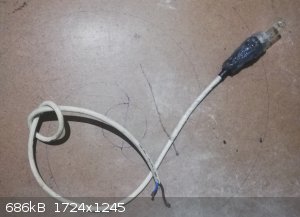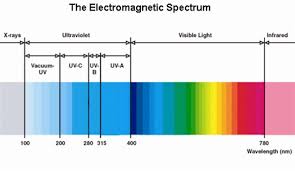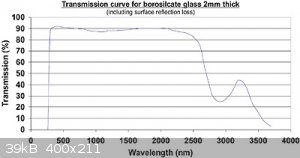nimgoldman
Hazard to Others
  
Posts: 303
Registered: 11-6-2018
Member Is Offline
|
|
Blacklight as a light source for chlorination?
I am looking for an UV light source for small scale chlorinations (making benzyl chloride from toluene, chloroacetic acid from GAA etc.).
From what I've read here, the peak wavelengths for dissociation of free chlorine are 180-200 nm. This corresponds to UV-C (hard UV light) which is outside the
range of most blacklights. The blacklight fluorescent tubes and bulbs seem to be mostly UV-A.
According to not_important's post here, chlorinations can be triggered by light in the 300 - 380 nm range. This is UV-A and perhaps blacklight could be used ?
Such light can also be produced by high pressure mercury vapour lamp, but these are often shielded to filter out the hard UV (which is desired).
So far I looked at grow shops, they offer high pressure mercury vapour lamps for growing plants (simulates sunlight) but I haven't found their spectra
below 400 nm ... the lamps does not seem to be shielded though (there is just glass, not the milky white coating).
I have also looked into germicidal (UV-C) light sources, but these are either weak (11 W or less) or awful lot expensive. One 400 W UV-C germicial
lamp (low pressure mercury vapour) cost over 400 USD.
I am not sure about the required wattage though, some said that for a 1 L RBF I would need sth. like 250 W to get a reasonable reaction rate.
Any advice?
|
|
|
Chemetix
Hazard to Others
  
Posts: 375
Registered: 23-9-2016
Location: Oztrayleeyah
Member Is Offline
Mood: Wavering between lucidity and madness
|
|
Yes you can use various UV sources as a means to accelerate certain SN1 reactions. But you have to consider that most of the reagents/ solvents have
the transmission of a house brick to UV. Lowering the frequency to blue is apparently more useful. Blue LED lights will give more conversion due to
more flux of photons entering the reaction zone.
edit
Facepalm: said wavelength meant frequency....
[Edited on 21-11-2019 by Chemetix]
|
|
|
morganbw
National Hazard
   
Posts: 561
Registered: 23-11-2014
Member Is Offline
Mood: No Mood
|
|
Browse this.
Benzyl and Benzal chloride, Benzaldehyde and Benzoic Acid - Illustrated Practical Guide
A lot of detail given in this.
Edit: spelling mistake
[Edited on 11/20/2019 by morganbw]
|
|
|
rockyit98
Hazard to Others
  
Posts: 283
Registered: 12-4-2019
Location: The Known Universe
Member Is Offline
Mood: no mood is a good mood
|
|
i'm using one of these https://www.ebay.com/sch/i.html?_from=R40&_nkw=uvc+bulb&...
only 3$
"A mind is a terrible thing to lose"-Meisner
|
|
|
nimgoldman
Hazard to Others
  
Posts: 303
Registered: 11-6-2018
Member Is Offline
|
|
Thanks, I will probably first try the reaction at microscale with the cheap UV-C bulb and see.
Professionals seem to use "quartz immersion wells" where the light source is suberged directly into the reaction mixture.
According to that page, it seems borosilicate glass effectively cuts off UV radiation below 300 nm (they actually use it as a filter) so an UV-B lamp,
or UV-C with some bleeding into the UV-B band is probably more efficient for an amateur on budget with humble Boro 3.3 glass.
I plan to purchase one of the 10 L reactors (basically a wide mouth RBF), so maybe a makeshift photochemical reactor could be made from a 50 or 100 mL
quartz flask (to hold the lightbulb), ground glass tubing (a shaft for the cable) and some gaskets to seal it. This still won't be as efficient as the
professional reactor, but should be pretty close.
[Edited on 20-11-2019 by nimgoldman]
|
|
|
SWIM
National Hazard
   
Posts: 970
Registered: 3-9-2017
Member Is Offline
|
|
My quartz immersion well is double layered.
Supposed to take water flowing between the layers to keep the heat from the big old 400 watt bulbs they use.
I haven't seen any numbers on how much uvc will get through 5 or 6 mm of water. But from the graphs I've seen it looks like its not too bad.
The same reactors come with glass immersion wells too (much cheaper and easier to find used). They're also water cooled and take similar high wattage
lamps.
Most of these wells can't be used with other labware easily as they are some oddball joint size like 60/40.
However some are just smooth and take an Ace threaded fitting and o-ring to set them in place.
Vycor is highly transparent to UVC as well. I've though about sticking a Vycor Erlenmeyer through the large (34/45?) center hole in a Pyrex polymer
reaction kettle and sealing it into the joint with silicone of suchlike.
The neck on a 250 ml Vycor Erlenmeyer is about the right diameter to fit in the hole.
UVC lamps for water sterilization or algae control often come with quartz sleeves that ought to do the trick if you can seal them into your glassware
in an airtight way.
I believe they are mostly the low pressure kind, which don't get as hot and probably don't need water cooling.
I had a look at that reference you posted, and it seems to say low pressure lights make several times more photons per watt.
If I'm reading this right, then its something to bear in mind when comparing lamps for photochemistry.
BTW: There are a couple of tiny microscale Ace photochemical reactors going cheap on ebay right now, but they have no immersion well or Ace-thread
fitting cap. And by tiny I mean like 50 ml for the big one, and 10 ml for the really tiny one.
Still, the Ace-thread caps in that size wouldn't be too hard to find, and I have seen UVC disinfection lights with quartz sleeves in that size range
on ebay before.
I think they were for something like disinfecting the vents in your car's air conditioner. Little low wattage things they were, but maybe good enough
for a 10 ml reactor?
[Edited on 21-11-2019 by SWIM]
|
|
|
rockyit98
Hazard to Others
  
Posts: 283
Registered: 12-4-2019
Location: The Known Universe
Member Is Offline
Mood: no mood is a good mood
|
|
you can put one in side of quartz tube or use silicon .RTV silicone is somewhat conductive because leftover Acetic acid .insulate wires first. watch
this first https://www.youtube.com/watch?v=aBrLeOVBCaE

"A mind is a terrible thing to lose"-Meisner
|
|
|
Sulaiman
International Hazard
    
Posts: 3558
Registered: 8-2-2015
Location: 3rd rock from the sun
Member Is Offline
|
|
I just ordered two of the cheap uv lamps similar to the one pointed to by rockyit98 ;
"3W UV Bulb Ozone Sterilizing Lamp E17 Refrigerator Ultraviolet Germicidal Lamp"
How can I determine which wavelengths are radiated from the lamp
... given that I do not have a uv spectrometer.
or
Can anyone identify a substance that fluoresces due to uvc (184 and/or 254 nm Hg lines) that is different from its behaviour when exposed to uvb or
uva ?
CAUTION : Hobby Chemist, not Professional or even Amateur
|
|
|
Herr Haber
International Hazard
    
Posts: 1236
Registered: 29-1-2016
Member Is Offline
Mood: No Mood
|
|
Quote: Originally posted by Sulaiman  |
Can anyone identify a substance that fluoresces due to uvc (184 and/or 254 nm Hg lines) that is different from its behaviour when exposed to uvb or
uva ? |
Uranium glass ?
I brought 2 pieces of glass at the dentist about a year ago because I wanted to see how it would react to the UV light used to harden resin.
To my surprise it barely fluoresced (is that a verb?)
Cheap tubes and even diodes work a lot better for that use.
Since they use eye protection when curing resin and the light is barely visible I suppose their wavelength is close to what you need.
The spirit of adventure was upon me. Having nitric acid and copper, I had only to learn what the words 'act upon' meant. - Ira Remsen
|
|
|
rockyit98
Hazard to Others
  
Posts: 283
Registered: 12-4-2019
Location: The Known Universe
Member Is Offline
Mood: no mood is a good mood
|
|
Quote: Originally posted by Sulaiman  | I just ordered two of the cheap uv lamps similar to the one pointed to by rockyit98 ;
"3W UV Bulb Ozone Sterilizing Lamp E17 Refrigerator Ultraviolet Germicidal Lamp"
How can I determine which wavelengths are radiated from the lamp
... given that I do not have a uv spectrometer.
or
|
you can smell the O3 from the bulb.that's good enough for me.
you need a ballast for ac power , in my case capacitor to lower the current.for dc power you can use 18v with constant current function set to
250mA.using one of these https://www.ebay.com/itm/5A-CC-CV-Adjustable-Display-Step-Do...
this one with no display https://www.ebay.com/sch/i.html?_from=R40&_nkw=5A+CC%2FC...
[Edited on 21-11-2019 by rockyit98]
"A mind is a terrible thing to lose"-Meisner
|
|
|
Tsjerk
International Hazard
    
Posts: 3022
Registered: 20-4-2005
Location: Netherlands
Member Is Offline
Mood: Mood
|
|
What about uv-c LED?
A random site I found :
https://www.ledwv.com/uv/uvc-leds-c-31.html?gclid=Cj0KCQiAiN...
|
|
|
Ubya
International Hazard
    
Posts: 1232
Registered: 23-11-2017
Location: Rome-Italy
Member Is Offline
Mood: I'm a maddo scientisto!!!
|
|
some tlc plates fluoresce at 254nm, but not in the uva range.
scheelite and fluorite fluoresce under shortwave uv but not uva. calcite also fluoresce under uvc but it depends on the sample so it is not really
reliable as a test
---------------------------------------------------------------------
feel free to correct my grammar, or any mistakes i make
---------------------------------------------------------------------
|
|
|
Ubya
International Hazard
    
Posts: 1232
Registered: 23-11-2017
Location: Rome-Italy
Member Is Offline
Mood: I'm a maddo scientisto!!!
|
|
many uvc bulbs have a coating to absorb the 185nm line, the one that excites oxygen to then produce ozone. on ebay you can sometime choose an ozone
producing bulb or not
---------------------------------------------------------------------
feel free to correct my grammar, or any mistakes i make
---------------------------------------------------------------------
|
|
|
wg48temp9
National Hazard
   
Posts: 761
Registered: 30-12-2018
Location: not so United Kingdom
Member Is Offline
|
|
Yes the germicidal lamps do not necessarily produce ozone in any nose detectable quantities and therefore it can be assumed they emitte very little
power from the 185nm emission line.
I purchased a 20w germicidal lamp, a four bar compact type. Almost one meter arc length for only 20w which suggests its low pressure and should
produce more 185nm UV than a higher pressure lamp but it does not produce any detectable ozone.

I have two other small UV lamps (a few watts) that have quartz envelopes according to their specs. After about ten seconds of operation I can detect
the smell of ozone created by them.
The 20W germicidal lamp does not appear to have a coating. I suspect the envelope glass absorbs the 185nm UV although its marked as UVC. The problem
apparently is some authorities do not consider is 185nm part of UVC.

So if you want the 185nm UV make certain the spec states it produces ozone and the envelope is made of quartz. Then if it produces no ozone you can at
least get your money back.
As you can see from the transmission graph of borosilicate 2mm thick has almost zero transmission at 185nm. So to use 185nm you will need a quartz
reaction chamber or mount the lamp inside or protruding in to the chamber and then some how seal the connections or seal the protrusion. Ebay
presently has 20W 4 bar germicidal lamps identical in appearance to the one I purchased but the description does state the envelope is quartz and
that it produces ozone. Sealing a four bar lamp protruding in to a reaction chamber will be tricky.

I am wg48 but not on my usual pc hence the temp handle.
Thank goodness for Fleming and the fungi.
Old codger' lives matters, wear a mask and help save them.
Be aware of demagoguery, keep your frontal lobes fully engaged.
I don't know who invented mRNA vaccines but they should get a fancy medal and I hope they made a shed load of money from it.
|
|
|
SWIM
National Hazard
   
Posts: 970
Registered: 3-9-2017
Member Is Offline
|
|
I bought one of those a few weeks ago.
It is about .5 mm too large to fit in an Ace quartz immersion well, just in case anybody's wondering about that.
It will also not quite fit into the large hole in the center of a Pyrex polymer kettle.
The 3 watt UVC bulbs mentioned above sound like a model I'm familiar with.
Does it have a weirdly shaped top that looks like the center of a Fresnel lens?
Mine are rated at 0.13 Watts of UVC output, and it's supposed to emit both 254 and 185 nm wavelengths.
I believe they are used in toothbrush sterilizers.
|
|
|
SWIM
National Hazard
   
Posts: 970
Registered: 3-9-2017
Member Is Offline
|
|
Make that 0.18 watts.
|
|
|
wg48temp9
National Hazard
   
Posts: 761
Registered: 30-12-2018
Location: not so United Kingdom
Member Is Offline
|
|
I thought Sulaimen posted comparison between the UV intensity of sunlight and a 3W UV bulb but I don't see it now.
Was it deleted for some reason?
I am wg48 but not on my usual pc hence the temp handle.
Thank goodness for Fleming and the fungi.
Old codger' lives matters, wear a mask and help save them.
Be aware of demagoguery, keep your frontal lobes fully engaged.
I don't know who invented mRNA vaccines but they should get a fancy medal and I hope they made a shed load of money from it.
|
|
|
Sulaiman
International Hazard
    
Posts: 3558
Registered: 8-2-2015
Location: 3rd rock from the sun
Member Is Offline
|
|
Sorry - I deleted it as I realised that it added nothing to the conversation,
but now I'm adding this post to explain 
The 3W lamps that I ordered are rated at 450 uW/cm2 of uv light at a distance of 3cm,
tropical sunlight at noon has about 27 uW/cm2 uv,
so the lamp at 12cm is equivalent to full sunlight in total uv power terms,
but the lamp is more hazardous than the sunlight,
as the uvc component of sunlight is mostly absorbed by the atmosphere.
I'm developing an interest in ozone chemistry due to this topic so I also asked
... anyone here done any ozone chemistry.
Sorry for any confusion caused.
CAUTION : Hobby Chemist, not Professional or even Amateur
|
|
|
G-Coupled
Hazard to Others
  
Posts: 287
Registered: 9-3-2017
Member Is Offline
Mood: Slightly triturated
|
|
Wow - that seems pretty good for a 3W lamp. 
Surely that's a usable amount of UV for some rxns?
|
|
|
Sulaiman
International Hazard
    
Posts: 3558
Registered: 8-2-2015
Location: 3rd rock from the sun
Member Is Offline
|
|
Good emoticon ... protect your eyes if messing with uv lamps 
CAUTION : Hobby Chemist, not Professional or even Amateur
|
|
|
wg48temp9
National Hazard
   
Posts: 761
Registered: 30-12-2018
Location: not so United Kingdom
Member Is Offline
|
|
I was going to say back in the late summer I attempted to make benzopinacol from benzophenone dissolved in propanol and exposed to sun light for
several days. I accidentally broke the flask and lost the reactants.
If your irradiance levels are correct I could repeat the experiment with a 3W UV bulb or better my 30W bulb and it would only take as long as
sunlight. Apparently its 355nm UV that's required so a borosilicate flask could be used. I had assumed sunlight had a lot more UV than a UV bulb of
only a few watts .
I am wg48 but not on my usual pc hence the temp handle.
Thank goodness for Fleming and the fungi.
Old codger' lives matters, wear a mask and help save them.
Be aware of demagoguery, keep your frontal lobes fully engaged.
I don't know who invented mRNA vaccines but they should get a fancy medal and I hope they made a shed load of money from it.
|
|
|
Ubya
International Hazard
    
Posts: 1232
Registered: 23-11-2017
Location: Rome-Italy
Member Is Offline
Mood: I'm a maddo scientisto!!!
|
|
Quote: Originally posted by wg48temp9  | I was going to say back in the late summer I attempted to make benzopinacol from benzophenone dissolved in propanol and exposed to sun light for
several days. I accidentally broke the flask and lost the reactants.
If your irradiance levels are correct I could repeat the experiment with a 3W UV bulb or better my 30W bulb and it would only take as long as
sunlight. Apparently its 355nm UV that's required so a borosilicate flask could be used. I had assumed sunlight had a lot more UV than a UV bulb of
only a few watts . |
i actually did this experiment at university. we did it in a borosilicate vial, putting it on a window sill in the lab for a week (may). the yield was
calculated but i don't have it right now to share
---------------------------------------------------------------------
feel free to correct my grammar, or any mistakes i make
---------------------------------------------------------------------
|
|
|
Texium
|
Thread Moved
29-11-2023 at 12:01 |